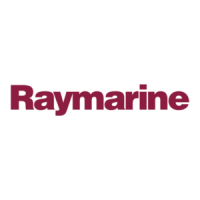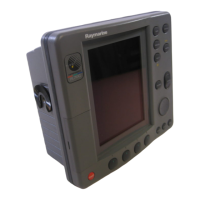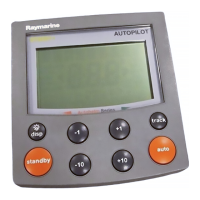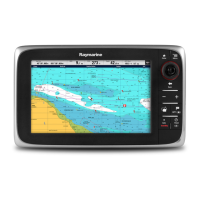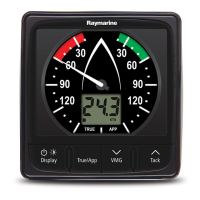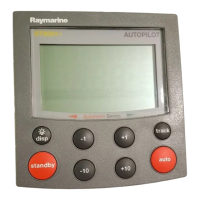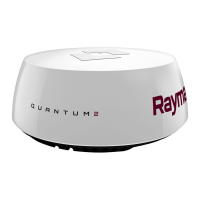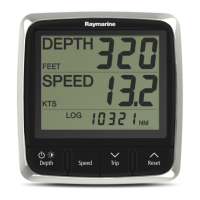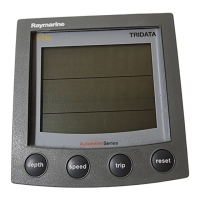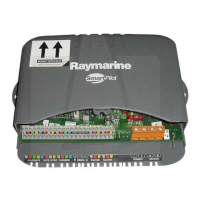Do you have a question about the Raymarine hsb2 PLUS Series and is the answer not in the manual?
Details the trackpad, dedicated keys, soft keys, pop-up menus, and database lists for system interaction.
Lists key features of the Chartplotter, including C-MAP NT support, data integration, and display modes.
Details how to customize displayed information, units, bearing mode, and autopilot integration.
Explains full-screen and half-screen display modes for radar, chart, and data log functions.
Introduces the chapter's focus on getting started and familiarizing with the display and controls.
Provides instructions for powering the unit on/off, magnetron warm-up, and standby/scanner off modes.
Guides on selecting display modes like Radar, Chart, or Data Log using the DISPLAY key.
Explains how to use the SCREEN soft key to toggle cursor data box, radar range rings, and chart grid on/off.
Details functions like Zoom, Offsetting the Center, and Hiding the Ship’s Heading Marker (SHM).
Covers moving around the chart, changing the chart center, and using FIND SHIP for synchronization.
Provides guidelines for waypoint management, route creation, and radar/chart synchronization.
Explains how to select and adjust radar range scales for optimal viewing of targets at different distances.
Covers understanding radar echoes and using controls like Gain, Sea Clutter, and Rain Clutter for clarity.
Explains how to use VRM/EBLs to measure range and bearing to targets, and control data boxes.
Covers setting up guard zones and controlling associated alarms for safety.
Introduces the Mini Automatic Radar Plotting Aid for target tracking, risk analysis, and collision avoidance.
Explains how to change radar orientation modes like Head Up, North Up, and Course Up.
Explains the Man Overboard function for quickly returning to a lost person or object overboard.
Describes displaying cursors from other displays on radar or chart for target identification.
Explains how to insert, remove, and use C-MAP NT electronic chart cards for detailed area navigation.
Guides on placing, going to, editing, and erasing waypoints on the chart.
Guides on creating routes by placing new waypoints or selecting existing ones from the Waypoint List.
Explains how to follow a route forwards or in reverse, and the display indicators for the active target.
Outlines methods for maintaining database lists via SeaTalk, NMEA, or hsb2, including user cartridges.
Explains how to turn tracks on and specify the interval for saving track points based on time or distance.
Guides on using the VRM/EBL key to obtain accurate measurements of distance and bearing between two points on the chart.
Describes various chartplotter alarms like Arrival, Off Track, Anchor, Grounding, Countdown, and Alarm Clock.
Provides information on GPS status, tracking satellites, and setting up a SeaTalk Differential GPS.
Explains how to activate and view logged course data, position, CMG, and DMG at thirty-minute intervals.
Guides on accessing and changing system, radar, MARPA, advanced, and chart setup parameters.
Lists system parameters like Data Boxes, Bearing Mode, Cursor Reference, Day/Night, Help, Soft Keys, and Units.
Lists radar setup parameters like EBL Display, Timed Transmission, Marks Options, Custom Scale, Bearing Alignment, and Antenna Size.
Specifies MARPA parameters for target vectors, safe zone, and target history display.
Allows fine-tuning of radar settings including display timing, STC preset, and tune preset.
Lists chart setup parameters to customize chart features like text, orientation, objects, waypoints, vectors, and synchronization.
Provides an overview of installation instructions for hsb2 series LCD displays, simple and integrated systems.
Guides on considering display unit location, cable runs, and EMC performance before installation.
Guide to carefully unpacking the system and verifying all parts and accessories are present.
Considers convenience, access, interference, magnetic compass, cable runs, and environment for optimal mounting.
Details on routing and securing power, scanner, SeaTalk, hsb2, and NMEA cables for proper installation.
Specifies DC power requirements, grounding, and connections for external equipment.
Covers system checks, initial setup, transmission tests, and bearing alignment procedures.
Explains linking displays and other equipment via hsb2 and SeaTalk for data transfer and extended functionality.
Provides information on routine maintenance checks for the display unit, including cleaning and cable inspection.
Explains the three reset types: Factory Reset, Power-On Reset, and Picture Reset for system recovery.
Provides a table to identify common issues and their corrections for troubleshooting.
Lists contact information for Raymarine technical support via website, phone, and email for assistance.
Lists general specifications for the hsb2 Series 7" LCD Displays, including approvals, size, weight, mounting, and power.
Details radar features such as range scales, bearing accuracy, scanner control, MARPA, and zoom modes.
Lists chartplotter features including cartography, display modes, waypoints, routes, track history, alarms, and navigation information.
Describes high-speed bus, SeaTalk, NMEA input, SeaTalk output, and NMEA output interfacing capabilities.
Explains the purpose and connection of the SeaTalk Auxiliary Junction Box for GPS and beacon receiver integration.
Details connection procedures for Raystar GPS and Differential Beacon Receivers to the Auxiliary Junction Box.
Provides connection diagrams for Autohelm GPS and Differential Beacon Receivers to the Auxiliary Junction Box.
Details connecting the Raystar 112LP GPS and its Differential Beacon Receiver via the Auxiliary Junction Box.
Explains connecting the Raystar 114 Combined GPS/DBR to the display via the Auxiliary Junction Box.
Details connecting the Raystar 120 WAAS Satellite Differential Receiver to the display via the Auxiliary Junction Box.
Allows customization of chart features like text size, display detail, boundaries, soundings, contours, and icons.
Lists caution areas, fishing facilities, cable information, pipelines, and traffic separation schemes.
Details marine features such as tideways, currents, seabed conditions, and tide height.
Lists natural features like coastline, rivers, and cultural features like buildings, railways, and airports.
Details port information including berthing facilities, checkpoints, cranes, dams, and services.
Lists chart features for underwater rocks, wrecks, depth areas, and caution areas.
Defines data types like Position, Speed, Waypoint Data, Depth, Wind, Heading, and Alarms received via SeaTalk/NMEA.
Details data transmitted on SeaTalk and NMEA Out, including Position, Speed, Waypoints, Depth, and Radar data.
Provides connection details for G-Series course computers via NMEA for heading data, and System Set Up recommendations.
Lists abbreviations starting with 'A', such as Amp, ANSI, AWG, BDI, Brg, CCFL, CD, CFR, CMG, COG, CRT, CTR, dB, DC, DMG, DR, EBL, EMC, ETA, FCC, FLT, ft, FTC.
Lists abbreviations starting with 'lat' through 'ZMB', including LCD, lon, M, MARPA, MBS, mm, MOB, MRK, nm, NMEA, POS, RF, Rng, rpm, SSB, SHM, SOG, STC, T, TFT, TTG, V, VHF, VMG, VRM, WPT, XTE, yds, ZMB.
| Brand | Raymarine |
|---|---|
| Model | hsb2 PLUS Series |
| Category | Marine Equipment |
| Language | English |
